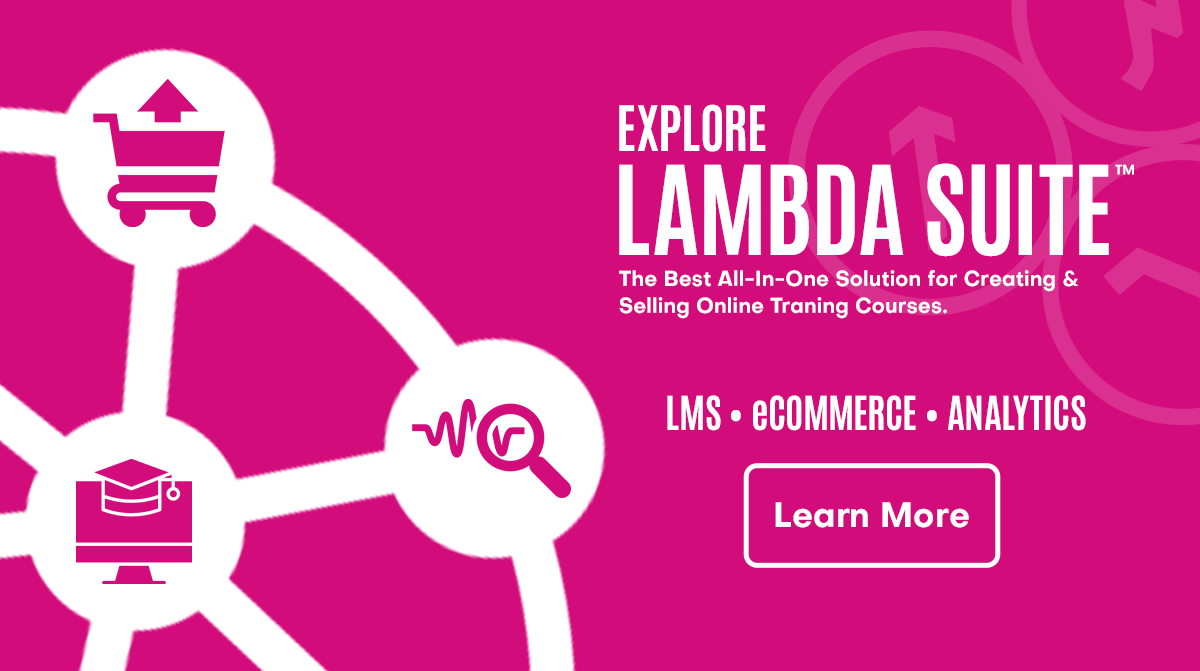
The eLearning industry has grown hugely as technology has improved and internet access has spread throughout the world. When a virus emerged sending society into a justified panic, the result of office and school closures furthered that growth If your movement is limited but you want to continue your development, online learning is your best option by far.
 Make Your Learning Course More Accessible
Make Your Learning Course More Accessible
For prospective content creators, this offers significant temptation. The rewards for producing eLearning materials can be substantial: monetary compensation is the chief motivator, but there’s also brand growth to be considered. The more you can do to educate others, the more you can establish yourself as a leader in your industry. But simply having remarkable insight isn’t enough to give you an edge. You also need to invest in accessibility.
In other words, you need to make your course optimally easy to find, choose, understand, and even share. To do anything less is to waste the effort needed to create it. And in this post, we’re going to run through some core tips for achieving course accessibility. Let’s get started.
Choose the right software foundation
It may be an obvious note in this context, but it’s essential that you choose a strong foundation for distributing your eLearning course. Online course platforms vary in quality, flexibility, and pricing, and it would be hugely inconvenient if you needed to change your platform down the line. Picking one and making a commitment is the way to go.
 Choose fully-integrated online course platform
Choose fully-integrated online course platform
You’ll also need to decide what tier to opt for (since the provided features vary), so you should think carefully about what you hope to achieve with your eLearning course. Achieving supreme accessibility will require extensive options, of course, so be prepared to make a strong financial investment if you’re determined to make that a reality.
Once you’ve done so, though, it’s imperative that you make a concerted effort to understand the options at your disposal. For the Lambda Suite, that means brushing up on the resources, taking full advantage of the knowledge base, and leaning on support whenever useful. The faster you get to grips with the system, the faster you’ll be able to use it to complete effect.
Maximally simplify your phrasing
It’s all too easy to take invaluable information and present it in a confusing way. The hallmark of a great eLearning course isn’t necessarily complexity or even accuracy: it’s clarity. And in most cases, this is achieved through simplicity. It’s been said that your level of expertise on a certain topic is reflected by how simply you can explain it. So how basic are your explanations?
Read through your course materials and gauge how straightforward they are. Better yet, task a beginner to the subject with reviewing the materials for you as they proceed through them. Is there a point at which the pace slows? Do you introduce difficult constructions without adequately breaking them down? The first time you mention a term, you should offer any necessary context. Most learners won’t know where to start otherwise.
You may want to include a glossary of the most-used terms, and link to it throughout your content so learners can look things up very easily. If you find yourself struggling, don’t be too reluctant to hire a dedicated copywriter, ideally with a background in technical writing. They can help you draw out the right framing and polish everything to a mirror shine.
Translate it into other languages
When people think of accessibility, they often forget to consider the biggest barrier to understanding: the language barrier. There are online learners around the world who’d like to engage with your course, but they can’t do that if you only offer it in your native tongue. So how can you cater to them? Quite obviously, you need to invest in a strong translation process.
 Biggest barrier to understanding: The language barrier
Biggest barrier to understanding: The language barrier
It’s become common over the years for content management systems to offer integrations with translation services. Anyone who’s produced an international blog knows this well: you can easily find WordPress translate plugins to translate your site affordably. This isn’t so common with online course platforms, but it’s fundamentally the support for languages that matters.
You just need to arrange the translation through a third-party service. You could automate the process using a free service, but we’ve already discussed the need for clarity. Deep-learning services like Deepl Translate can get impressive results, admittedly, but it’s still best to get human input.
Enhance the variety using rich media
Think of people who suffer from ADHD or similar afflictions. They want to pay attention, but their minds keep darting back and forth. This makes long stretches of text extremely difficult for them. They need variety in the content they consume, and that’s just one reason why your eLearning course materials should include videos, podcasts, and even games if you can manage them. The more you can mix things up, the easier it’ll be to keep people hooked.
The other big reason for using varied types of rich media is that it’s often easier to explain a tricky concept using visuals. Though the truth of a picture being worth a thousand words is somewhat complicated, it’s undeniable that a strong picture is more immediately arresting and more valuable when you’re trying to reach something practical like repairing electrical systems. People can’t usefully be told about circuits: they need to actually see them in operation.
If you can, put together some talking-to-camera pieces. Being able to see someone’s face while learning can yield a surprising improvement. This will also help with brand perception, as the perceived authority of the person doing the speaking will rise in the process. Due to this, though, it’s vital to choose the right person to do the presenting. Ideally, it should be the course creator.
Support different interaction types
We briefly touched upon the notion of including games in your course materials — but what do we mean by that? Side-scrolling platform adventures? Well, no (probably not, at least). Games don’t need to be complicated. Something as simple as a quiz with relevant questions counts as a game. What’s important is the element of interactivity, as interaction is engaging.
 Interactive learning with Gamification
Interactive learning with Gamification
The more you allow learners to sit back and passively absorb your course materials, the more you risk losing their attention. You might wonder why that’s a problem (if they’ve already paid for your course, then your financial reward is secure), but look at it this way: how they feel about the course once they’re done will have a huge impact on your long-term success, as their harsh review could discourage others from investing in your expertise.
And when you think about interactivity, you should keep the existence of various device types in mind. A given learner might be accessing your course via a desktop computer, a laptop, a tablet, or a smartphone — and then there’s the divide between operating systems and browsers. How does your course content respond to touch inputs versus clicks? Are your buttons presented with sufficient obviousness?
Ensure strong contrast at all times
Following on from the obviousness of buttons, we need to consider the need for contrast, particularly of the visual kind. Not everyone has perfect vision, after all. Many people have trouble differentiating between certain colors, for instance, or can’t see very sharply even with corrective lenses. Catering to those people requires you to ensure that all the elements of your course materials are highly distinguishable in ways that will work for most people.
What makes a button obvious? Several things can factor into it. To name just some, you can think about color, brightness, size, shape, position, text, and animation. The key is always distinction, though. Making vital parts of your content stand out visually is a mission-critical concern. If you don’t manage this, you can even find that people get stuck midway through your course, uncertain about how to proceed.
A good way to handle this is to read up on accessibility requirements and use handy tools (like this contrast checker) to test your content. Don’t worry if you can’t achieve perfect scores across the board. You don’t need perfect accessibility. Just do what you can, and pay attention to feedback from learners so you can take action when you fall short in a key area.
Collaborate with key influencers
Lastly, an aspect of accessibility that we’ve yet to address is marketing. While it isn’t necessary to dwell on it (there’s enough out there about marketing already), it does bear noting that your target learners do need to learn about the existence of your course to consider it. And when you’re trying to reach people, a high-value option is to collaborate with relevant influencers.

Suppose for the sake of argument that you’re trying to sell a course on welding. If you look around, you’ll find numerous people across Twitter and Facebook who habitually talk about welding. While many of them will be professionals who’d rather not endorse courses when they could create their own, many others will be amateurs who have more enthusiasm than expertise. They have followers, and you have advice. Why not bring them together?
You could agree a simple deal with such an enthusiast: they promote your course, and you give them a modest commission whenever one of their followers signs up. It’s a fair arrangement. Do your research before deciding, though: you want to work with honest influencers to attract people who’ll actually benefit from your course. It’s no use winning conversions if they only lead to refunds because the buyers were brought to you under false pretenses.
Conclusion
You’ve already been sold on the value of eLearning, and you’ve taken the time and energy to produce a full eLearning course. Having put in all that effort, you owe it to yourself to push the ROI as far as it can go — and core to that process is improving accessibility. This will allow you to attract (and impress) the people who will become your biggest supporters.
And while you won’t find an exhaustive list of recommendations that can unerringly yield ideal accessibility, the suggestions we’ve covered here will allow you to make tremendous strides in your quest for new learners. The sooner you get started, the sooner you can bolster your clarity, ramp up your contrast, and liven up your media portfolio. Good luck.




